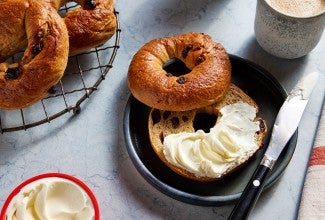-
To make the dough: Weigh your flour; or measure it by gently spooning it into a cup, then sweeping off any excess. Place the flour, sugar, yeast, salt, and xanthan gum in a bowl, or the bowl of your stand mixer. Mix until combined.
-
Add the milk. Using an electric mixer (hand mixer, or stand mixer fitted with the flat beater, not the dough hook), mix on medium to medium-high speed to make a very smooth, thick batter, about 3 minutes.
-
Scrape down the sides of the bowl and transfer the dough to a lightly greased bowl. Grease the top of the dough, then cover the bowl and let the dough rise at room temperature until it’s visibly puffy, about 2 hours.
-
Turn the dough out onto a well-greased surface. Generously grease your hands and deflate the dough by gently kneading until smooth.
-
Divide the dough into six equal pieces (about 103g each).
-
To shape the bagels: Line a baking sheet with parchment and lightly grease the parchment. Set aside.
-
Roll each piece of dough into a ball, then use your cupped fingers and palm to roll the dough into a tight ball, moving your hand in a circular motion. Re-grease the surface and your hands as needed to prevent dough from sticking.
-
Keeping the ball of dough on the work surface, poke a greased finger through the center and move it in a circular motion to create a bagel shape. Aim for a hole that’s about 3/4” to 1” in diameter.
-
Gently pick up the bagel and round the edges. Place it on the prepared pan. Repeat with the remaining pieces of dough.
-
Cover the bagels and allow them to rest for 45 to 60 minutes.
-
While the bagels are resting, preheat the oven to 450°F. Combine the water and sugar in a wide, shallow pot; the water should be at least 1 1/4" deep. Bring the mixture to a boil.
-
To boil the bagels: Add bagels to the water two or three at a time to avoid crowding. Boil for 60 seconds, then use a slotted spoon or dough whisk to gently turn the bagels over. Boil for another 60 seconds before transferring from the water back to the prepared pan. Repeat until all the bagels have been boiled and are on the pan.
-
To bake the bagels: Bake the bagels until they’re golden brown, 20 to 24 minutes. Rotate the pan (front to back, back to front) halfway through baking to ensure even browning.
-
Remove the bagels from the oven and transfer them to a rack to cool.
-
Gluten-free bagels are best served the day they’re made, while still slightly warm from the oven. Cooled bagels can be reheated and crisped in the toaster. Wrap and freeze any leftover bagels. To reheat frozen bagels, thaw, then toast for the best eating experience.


















